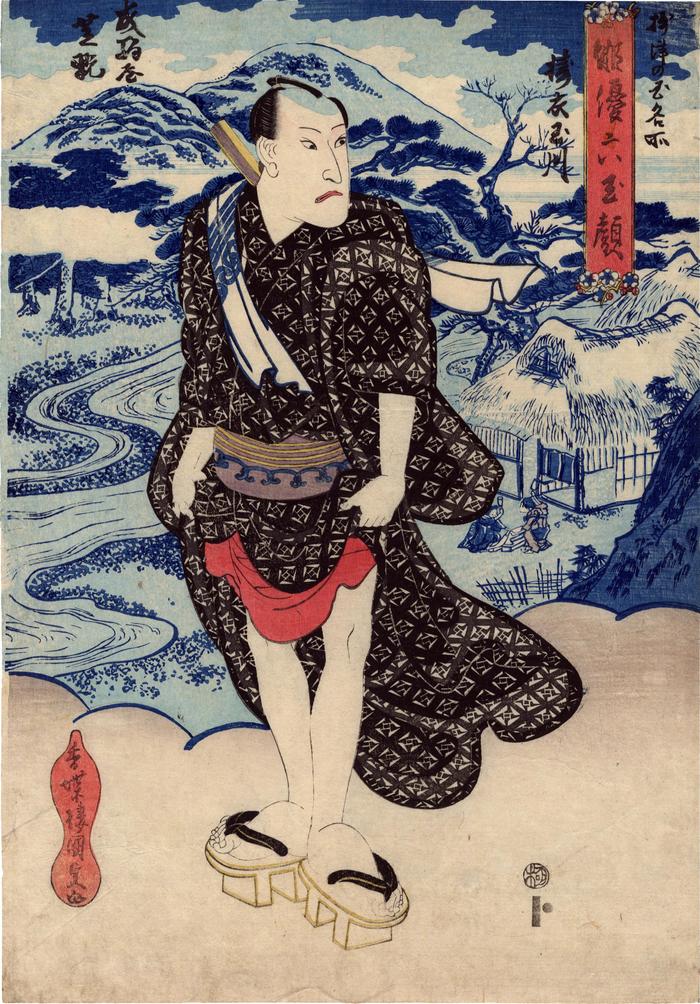Utagawa Kunisada (歌川国貞) / Toyokuni III (三代豊国) (artist 1786 – 01/12/1865)
Nakamura Shikan II as Narikoyama in the series 'Actors with Six Jewel Faces' (Haiyū mutama-gao - 俳優六玉顔)
1832
10.25 in x 15 in (Overall dimensions) Japanese color woodblock print
Signed: Kōchōrō Kunisada ga
香蝶楼国貞画
Publisher: Yamagucihya Tōbei
(Marks 591 - seal 15-005)
Censor's seal: kiwame
Waseda University Theater Museum
Lyon Collection - Yamatoya Baiga from this series
Lyon Collection - Bandō Hikosaburō IV from this series
Lyon Collection - Bandō Mitsugorō IV from this series
Nationaal Museum van Wereldculturen (Rijksmuseum Volkenkunde, Leiden) via Ritsumeikan University
Lyon Collection - an 1847 Kuniyoshi triptych also of the Tōi Crystal River showing a woman fulling cloth
Lyon Collection - a Hokusai book illustration showing a woman fulling cloth The Six Jewel Rivers were noted beauty spots of antiquity. The title of this series is a pun on the words kawa (river) and kao (face). In this magnificent set, for the landscape background Kunisada took advantage of the fashionable vogue for prints in the new imported Prussian blue pigment (aizuri-e). This particular river may be the Tōi no Tamagawa (梼衣玉川) or 'Cloth-fulling River' in Settsu Province. In the aizuri-e background it shows two women squatting down, outside of a cottage, pounding cloth on a small frame, i.e., fulling.
****
On page 5 of Amy C. Riggs' September 2017 doctoral dissertation from Princeton she wrote about fulling in ancient China. She noted: "By the Tang dynasty, fulling cloth has become a common poetic trope. As poets freely adopted the sight and sound of fulling cloth, it came to signify a soldier's longing for home, wistfulness for those who were away, the advent of autumn, and pending departure of dear ones."
On page 6 Riggs noted that there is a tomb from the time of the Jurchen Jin dynasty (1115-1234) showing a scene of fulling. This would imply an other-worldly importance to this act.
Referencing the work of a modern Chinese scholar, Riggs added on page 18 that during the Tang dynasty, "Instead, they start to invoke the sight and sound of fulling cloth as symbols of parting of friends, longing for home, missing families and friends, and the arrival of autumn."
****
Two prints from this set are illustrated in Izzard, Kunisada's World page 142 cat #s 66/1 and 66/2).
****
Illustrated in color in Ukiyo-e Masterpieces in European Collection 5: Victoria and Albert Museum II, Kodansha, 1989, #11.
Yamaguchiya Tōbei (山口屋藤兵衛) (publisher)
actor prints (yakusha-e - 役者絵) (genre)
blue prints (aizuri-e - 藍摺絵) (genre)
Nakamura Shikan II (二代目中村芝翫: 11/1825 - 12/1835) (actor)
landscape prints (fūkeiga 風景画) (genre)
